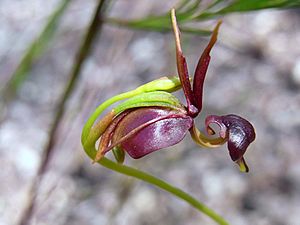Large duck orchid facts for kids
Quick facts for kids Large duck orchid |
|
|---|---|
 |
|
| Scientific classification | |
| Genus: |
Caleana
|
| Species: |
major
|
| Synonyms | |
|
|
The large duck orchid (scientific name: Caleana major) is a super cool and unique flower found in eastern and southern Australia. It's called the "duck orchid" because its flower looks exactly like a duck flying! This amazing plant uses its duck-like shape to attract certain insects, like male sawflies. These insects help the orchid make new seeds in a special way, where they try to "mate" with the flower. In 1986, this special orchid was even shown on an Australian postage stamp.
Contents
What Does It Look Like?
The large duck orchid grows from a tuber (a kind of underground stem, like a potato). It's a perennial plant, meaning it lives for more than two years. It usually grows to be about 200–400 mm (8–20 in) tall. It has one reddish, narrow leaf that is about 40–130 mm (2–5 in) long and 4–8 mm (0.2–0.3 in) wide. This leaf often has spots and grows from the bottom of the plant.
The plant can have up to five shiny reddish-brown flowers. Each flower is about 20–25 mm (0.8–1 in) long and 6–7 mm (0.2–0.3 in) wide. They grow on a thin, wire-like stem. Sometimes, very rarely, you might see a greenish flower with dark spots!
The parts of the flower that look like petals (called sepals and petals) are about 12–15 mm (0.5–0.6 in) long and have pointy tips. The main part of the flower, called the labellum, is about 6–8 mm (0.2–0.3 in) long and 5–6 mm (0.20–0.24 in) wide. This labellum is the part that looks like a duck's head on a thin "neck." You can usually see these amazing flowers from September to January.
How It Got Its Name
The large duck orchid was first officially described in 1810 by a botanist named Robert Brown. He found a sample of the plant in September 1803 at Port Jackson in Australia. He wrote about it in his book, Prodromus Florae Novae Hollandiae et Insulae Van Diemen.
The name of the group of plants (the genus name, Caleana) was given to honor George Caley. He was an early plant collector. The second part of the name (the specific epithet, major) is a Latin word that means "large" or "great." So, its name basically means "Caley's large plant."
Where It Lives
You can find the flying duck orchid in many parts of Australia. It grows in Queensland, New South Wales, Victoria, South Australia, and Tasmania. It likes to grow in eucalyptus forests, along the coast in shrubby areas, in swampy lands, and in heathland (open areas with small shrubs). Most of the time, you'll find it close to the coast, but sometimes it grows in higher places too.
How It Reproduces
This orchid has a super clever way to get pollinated by insects! The labellum (the duck's head part) is held up by a sensitive, strap-like stalk. When an insect lands on it, the labellum quickly snaps downward. This traps the visiting insect between the labellum and another part of the flower called the column. The insect then helps to spread the pollen, allowing the orchid to make seeds.
Growing This Orchid
It's quite tricky to grow the large duck orchid outside of its natural home. Even when people try to grow them, the plants usually only flower for one or two years. After that, they slowly get weaker and eventually die.
See also
 In Spanish: Caleana major para niños
In Spanish: Caleana major para niños

